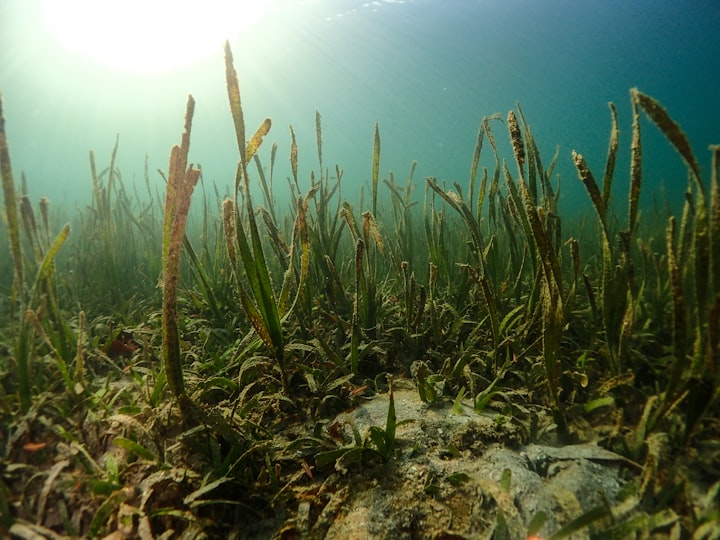The Ageless Seagrass
Exploring the Remarkable Longevity of Posidonia Oceanica

The world's oldest living creature is not a giant tortoise or a 200-year-old whale, but rather a humble seagrass. Known as Posidonia oceanica, this species of seagrass can live for thousands of years and forms extensive meadows in the Mediterranean Sea.
Posidonia oceanica belongs to a group of plants called angiosperms, which are the most diverse group of plants on Earth and include all flowering plants. However, unlike most other angiosperms, which live for just a few years, Posidonia oceanica is a perennial plant that can live for millennia.
One of the factors that allow Posidonia oceanica to live for so long is its ability to clone itself. The plant spreads through a system of rhizomes, which are underground stems that send up new shoots. Over time, a single plant can give rise to vast meadows that cover hundreds of square kilometers.
Another factor that contributes to the longevity of Posidonia oceanica is its slow growth rate. The plant grows just a few centimeters per year, and as it ages, it becomes more efficient at capturing nutrients and water from the surrounding environment.
Posidonia oceanica also plays a critical role in the Mediterranean ecosystem. The plant provides a habitat for a wide range of marine creatures, including fish, crabs, and sea urchins. It also helps to stabilize the sea floor and reduce erosion, which in turn helps to protect nearby beaches and coastal communities.
Despite the importance of Posidonia oceanica, the plant is under threat from a range of human activities, including coastal development, pollution, and overfishing. In recent years, conservation efforts have been underway to protect and restore seagrass meadows, including Posidonia oceanica, in the Mediterranean and beyond.
Studies have shown that seagrass meadows are some of the most productive ecosystems on Earth, and their preservation is critical to maintaining the health and biodiversity of our oceans. As we continue to learn more about the remarkable longevity of Posidonia oceanica and other seagrass species, we may gain new insights into the mechanisms that allow some organisms to live for thousands of years, and the ecological and evolutionary implications of these adaptations.
Seagrass meadows are also known to sequester large amounts of carbon, making them important tools in mitigating the impacts of climate change. Posidonia oceanica, in particular, has been found to sequester carbon at a rate of up to 15 grams per square meter per day, making it one of the most effective carbon sinks in the world.
The remarkable longevity of Posidonia oceanica has also captured the attention of scientists studying aging and longevity. Researchers have been studying the genetics of the plant, in the hopes of uncovering the secrets of its longevity and how it might be applied to humans.
While the study of Posidonia oceanica is still in its early stages, the potential implications of this research are vast. If we can unlock the mechanisms that allow this humble seagrass to live for thousands of years, we may be able to develop new treatments and therapies for age-related diseases and even extend the human lifespan.
Furthermore, the long lifespan of Posidonia oceanica also highlights the importance of conservation efforts to protect this vital seagrass species. Human activities such as coastal development, pollution, and climate change are putting seagrass meadows at risk around the world. Once these meadows are destroyed, they can take centuries to recover, and the loss of this critical habitat can have devastating impacts on marine ecosystems.
Efforts to protect and restore seagrass meadows are underway in many parts of the world. These efforts include measures to reduce pollution and promote sustainable fishing practices, as well as initiatives to restore damaged seagrass habitats. By working together to protect and restore these vital ecosystems, we can ensure that Posidonia oceanica and other seagrass species continue to thrive for thousands of years to come.
In conclusion, the discovery of Posidonia oceanica's remarkable longevity serves as a reminder of the incredible diversity and resilience of life on Earth. This humble seagrass has survived for thousands of years, adapting to changing environmental conditions and providing a vital habitat for countless marine species. By studying and protecting this remarkable plant, we may learn valuable lessons about the workings of our planet and the secrets of life itself.
Thanks a lot for reading! Please, do well to like it!
About the Creator
Derick Okwa
I am a fun and easing going guy who loves nature and the beautiful creatures inhabiting the earth with us. More reason I write articles about them.






Comments
There are no comments for this story
Be the first to respond and start the conversation.